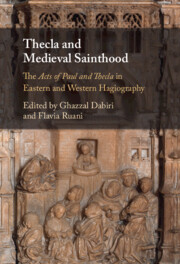Book contents
- Thecla and Medieval Sainthood
- Thecla and Medieval Sainthood
- Copyright page
- Contents
- Contributors
- Acknowledgments
- Abbreviations
- Introduction
- Part I An Act to Follow
- Chapter 1 A Cainite Invocation of Thecla?
- Chapter 2 Saint Thecla in Geʿez Hagiographical Literature
- Chapter 3 Versified Martyrs
- Chapter 4 The Reception of the Acts of Thecla in Armenia
- Chapter 5 Thecla beyond Thecla
- Chapter 6 Shifting the Poetics of Gender Ambiguity
- Part II An Act to Surpass
- Afterword
- Appendix Summaries of Texts
- Index
- References
Chapter 5 - Thecla beyond Thecla
Secondary Characters in Syriac Hagiography
from Part I - An Act to Follow
Published online by Cambridge University Press: 06 May 2022
- Thecla and Medieval Sainthood
- Thecla and Medieval Sainthood
- Copyright page
- Contents
- Contributors
- Acknowledgments
- Abbreviations
- Introduction
- Part I An Act to Follow
- Chapter 1 A Cainite Invocation of Thecla?
- Chapter 2 Saint Thecla in Geʿez Hagiographical Literature
- Chapter 3 Versified Martyrs
- Chapter 4 The Reception of the Acts of Thecla in Armenia
- Chapter 5 Thecla beyond Thecla
- Chapter 6 Shifting the Poetics of Gender Ambiguity
- Part II An Act to Surpass
- Afterword
- Appendix Summaries of Texts
- Index
- References
Summary
In recent years, the reception of Thecla and her tale, the Acts of Paul and Thecla, in Syriac Christianity has been the object of scholarly attention. Indeed, the presence of Thecla in various cultural mediums (literature, cult/liturgy, manuscripts, etc.) throughout the Syriac world seems to have been explored exhaustively and at different levels. However, the impact of the Acts of Paul and Thecla on the process of writing Syriac hagiography still needs to be addressed. This chapter, therefore, focuses on a form of reception which is less direct than those that already have been identified: in other words, it is not concerned with Thecla herself, but with other characters. The chapter illustrates that secondary characters from a selection of Syriac hagiographical texts are constructed based on those of the Acts of Paul and Thecla. The analyses demonstrate that the reception of Thecla goes beyond direct references to the heroine and concerns the construction of stories in deeper, more structural ways.
Keywords
- Type
- Chapter
- Information
- Thecla and Medieval Sainthood<I>The Acts of Paul and Thecla</I> in Eastern and Western Hagiography, pp. 142 - 174Publisher: Cambridge University PressPrint publication year: 2022



